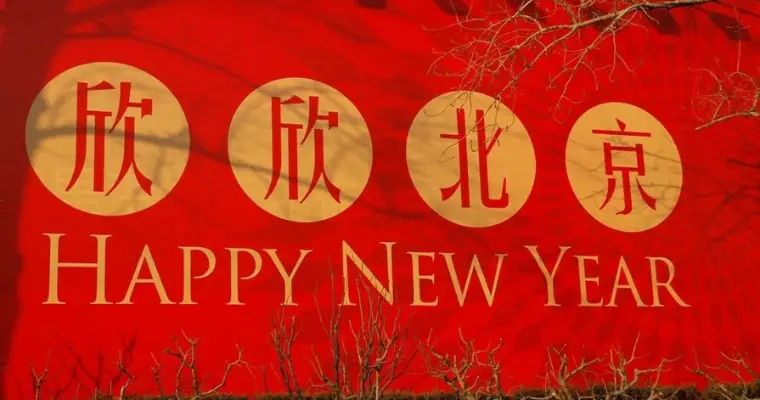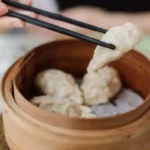Dragon Lunar New Year

As we usher in the vibrant and auspicious celebration of the Chinese Dragon Lunar New Year. It’s essential to understand the profound significance of the dragon in Chinese culture.
The dragon, a symbol of strength, power, and good fortune, has played a central role in Chinese folklore and traditions for centuries.
Representing the emperor’s authority and the spirit of renewal, the dragon is a dynamic emblem that holds a special place in the hearts of millions during this joyous occasion.
Indulge in the flavors of our delightful plant-based recipes, perfect for your Chinese New Year festivities!
Welcoming the Dragon Lunar New Year with Joy and Tradition
As families gather to welcome the Lunar New Year, there is the presence of dragon-themed decorations.
From vibrant red lanterns to dragon-shaped ornaments, signifies the hope for a prosperous and harmonious year ahead.
Traditional feasts featuring symbolic dishes, the exchange of red envelopes (hongbao) for good luck add to the festive atmosphere.
So, it’s a time when people reflect on the past and set positive intentions for the future, strengthening familial bonds and honoring age-old customs.
Dragon Zodiac Sign and Personality Traits
In the Chinese zodiac, the dragon is the only mythical creature and holds a unique position in the twelve-year cycle.
Consequently, individuals born in the Year of the Dragon are believed to embody the creature’s bold, ambitious, and passionate traits.
They frequently exhibit characteristics of charismatic leaders, as they are driven by a desire for success and personal growth.
Exploring the characteristics associated with the Dragon zodiac sign adds a layer of understanding to the cultural significance of this majestic creature during the Lunar New Year festivities.
Traditional Dragon Dances and Festivities
No Chinese New Year celebration is complete without the mesmerizing and energetic dragon dances that captivate audiences worldwide.
These intricate performances involve a team of skilled dancers manipulating a long, winding dragon puppet, typically made of silk, paper, and bamboo.
The dragon’s movements symbolize the lively spirit of the mythical creature, warding off evil spirits and ushering in prosperity.
Specifically, communities around the globe come together to witness these spectacular displays, fostering a sense of unity and cultural pride.
Modern Twists on Dragon Celebrations
As traditions evolve, modern interpretations of the Dragon Lunar New Year celebrations have emerged.
Contemporary dragon-themed art installations, digital dragon dances, and innovative culinary experiences infuse a sense of creativity into the festivities.
These modern twists reflect a dynamic cultural landscape that bridges the rich heritage of the past with the aspirations of the future.
Therefore, ensuring that the spirit of the dragon remains relevant and inspiring for generations to come.
Festive Celebration in Chinese Culture
Symbolism of Red:

Red is a prominent color during Chinese New Year celebrations, believed to symbolize good luck, happiness, and prosperity.
People often wear red clothing, decorate their homes with red ornaments, and exchange red envelopes containing money as a symbol of good fortune.
Cleaning and Decoration:
Before the arrival of the New Year, it is customary for families to thoroughly clean their homes. Mainly to sweep away any bad luck and make room for good fortune.
Families then decorate their homes with items such as Chinese couplets, paper cuttings, and symbolic images to attract positive energy.
Traditional Foods:
During the Chinese New Year, people celebrate with a variety of special dishes that hold symbolic meanings. This is not only a time to enjoy delicious food but also an opportunity for family members to come together, share stories, and strengthen family bonds.
For example, people commonly prepare and consume dumplings during this time, as they symbolize wealth and prosperity.
Nian gao, a sticky rice cake, symbolizes growth, advancement, and the promise of a better year.
Fireworks and Firecrackers:
The tradition of setting off fireworks and firecrackers during Chinese New Year has ancient roots.
People believe that the loud noises scare away evil spirits and bring good luck.
Fireworks displays are common in many Chinese cities, creating a vibrant and festive atmosphere.
Traditional Clothing:
During the Chinese New Year, it is common for people to wear traditional clothing. Items such as the qipao or cheongsam for women and the changshan for men.
People often adorn these garments with intricate designs and bright colors, contributing to the festive atmosphere.
Global Celebrations:
Chinese communities around the world celebrate Chinese New Year, not just in China.
Parades, cultural events, and traditional performances take place in various cities with significant Chinese populations, allowing people from diverse backgrounds to join in the festivities.
The Lantern Festival:
The 15th day of the Chinese New Year marks the Lantern Festival, signaling the end of the traditional New Year celebrations.
People celebrate by hanging colorful lanterns, solving riddles on lanterns, and enjoying various cultural performances. It is a beautiful and symbolic way to conclude the festive period.
Here are several Whole Food Plant-Based recipes that you can include in your Chinese New Year dinner:
Easy Steamed Dumpling Recipe
Equipment
- 1 Steamer basket 12-piece Capacity
- 1 Sharp Knife Fine Chopping
Materials
Mushroom Dumpling Filling
- 1 cup Finely Chopped Mushrooms Shiitake or Trumpet
- 1/2 cup Finely Chopped Cabbage Green or Red
- 1/3 cup Finely Chopped Carrots Orange or Purple
- 2 large Finely Chopped Green Onions
- 3 cloves Finely Chopped Garlic
- 1 inch Finely Chopped Fresh Ginger
- 2 Tbsps Tamari Low Sodium
- 1 Tsp Tahini Paste
- 24 round Dumpling Wrappers WonTon Wraps – Nasoya
Dipping Sauce
- 3 Tbsp Tamari Low Sodium
- 1 Tbsp Rice Vinegar
- 1 Tbsp Maple or Date Syrup
- 2 Tsps Finely Grated Fresh Ginger
- 1 Tsp Tahini Paste
- 1 Tsp Sriracha Or Chili Garlic Sauce To taste
- 1 Tsp + Water To Thin Sauce if needed
- 1 Tsp Finely Chopped in strips Fresh Ginger
- 1 Tbsp Rough Chopped Green Onions
- 1 Tsp White Sesame Seeds
Instructions
Filling Instructions
- In a mixing bowl, combine the chopped mushrooms, cabbage, grated carrots, green onions, minced garlic, tamari, tahini, and grated ginger. Mix well until all the ingredients are evenly incorporated. Open Wrapper Package
- Place a small spoonful of the mushroom filling in the center of each dumpling wrapper. Wet the edges of the wrapper with water, fold in half, and pinch the edges to seal. Repeat until all the filling is used.
- Prepare a steamer basket by lining it with parchment paper to prevent sticking. Arrange the dumplings in a single layer in the steamer basket, leaving space between them to prevent sticking together.
- Bring water to a boil in a pot or wok, then place the steamer basket on top. Cover and steam the dumplings for about 10-12 minutes, or until the wrappers are translucent and the fillings cooked through.
- Once steamed, remove the dumplings from the steamer and garnish with sesame seeds or green onions if desired.
Dipping Sauce Instructions
- In a small bowl, whisk together the low-sodium soy sauce or tamari, rice vinegar, date or maple syrup, grated ginger, tahini, and sriracha.Adjust the quantities according to your taste preferences.
- Transfer the dipping sauce to a serving dish and garnish with chopped ginger and green onions.
Notes
WFPB Sesame Garlic Veggie Noodles

Ingredients:
- 8 oz whole grain or brown rice noodles
- 1 cup broccoli florets
- 1 cup snow peas, ends trimmed
- 1 medium carrot, julienned
- 1 red bell pepper, thinly sliced
- 1 cup bok choy, chopped
- 4 green onions, sliced
- 3 cloves garlic, minced
- 1 tablespoon fresh ginger, grated
- 1/4 cup low-sodium tamari or soy sauce
- 2 tablespoons rice vinegar
- 1 tablespoon maple syrup
- 1 tablespoon toasted sesame oil (optional, omit for oil-free)
- 4 tablespoons toasted sesame seeds, for garnish
- Fresh cilantro, chopped, for garnish (optional)
Instructions:
Prepare Noodles:
- Cook the noodles according to package instructions. Drain and set aside.
Steam Vegetables:
- Steam broccoli, snow peas, carrot, red bell pepper, and bok choy until they are tender-crisp. Normally done using a steamer basket or by briefly boiling them. Set aside.
Prepare Sauce:
- In a small bowl, whisk together tamari or soy sauce, rice vinegar, maple syrup, and toasted sesame oil (if using).
Sauté Aromatics:
- In a large pan or wok, sauté minced garlic and grated ginger over medium heat until fragrant. Be careful not to burn them.
Combine and Toss:
- Add the steamed vegetables and cooked noodles to the pan. Pour the sauce over the noodles and vegetables. Toss everything together until well combined and heated through.
Serve:
- Garnish with sliced green onions, toasted sesame seeds, and fresh cilantro (if using).
Optional Additions:
- If you like some heat, you can add a pinch of cayenne pepper or a drizzle of sriracha for spice.
Nian Gao (Sticky Rice Cake)

Ingredients:
- 2 cups glutinous rice (soaked overnight)
- 1 cup sweet potato, grated
- 1 cup water
- 1 cup Medjool dates, pitted and chopped
- 1/2 cup unsweetened applesauce
- 1/2 cup raisins
- 1 teaspoon vanilla extract
- 1/2 teaspoon ground cinnamon
- Pinch of salt
Instructions:
Prepare the Glutinous Rice:
- Drain the soaked glutinous rice. Steam it until it becomes soft and sticky. This usually takes about 30-40 minutes.
Cook the Sweet Potato:
- Steam or boil the grated sweet potato until it becomes soft. Mash it thoroughly.
Prepare Date Paste:
- In a blender or food processor, blend the chopped Medjool dates with 1 cup of water until you get a smooth date paste.
Combine Ingredients:
- In a large mixing bowl, combine the steamed glutinous rice, mashed sweet potato, date paste, unsweetened applesauce, raisins, vanilla extract, ground cinnamon, and a pinch of salt. Mix well until all ingredients are evenly combined.
Bake:
- Preheat your oven to 350°F (175°C).
- Transfer the mixture into a glass baking dish or silicone mold.
- Smooth the top with a spatula.
- Bake for 40-45 minutes or until the top is golden brown.
Cool and Slice:
- Allow the sticky rice cake to cool completely before slicing. This will help it set and become firm.
- Once cooled, cut the Nian Gao into desired shapes. Traditionally, it’s often sliced into squares.
Serve:
- Serve the WFPB Nian Gao slices at room temperature or warm. You can enjoy it as is or lightly pan-fry for a slightly crispy exterior.
Wishing You a Prosperous Year of the Dragon
In conclusion, as we embrace the Chinese Dragon Lunar New Year, let us immerse ourselves in the rich traditions that define this joyous occasion.
The dragon’s mythical presence reminds us of the resilience and strength within, inspiring us to face the challenges of the coming year with courage and optimism.
May the spirited dragon dances, the warmth of family gatherings, and the echoes of festive celebrations bring joy, prosperity, and good fortune to all.
Here’s to a majestic and prosperous Year of the Dragon! Gong Xi Fa Cai!
Please leave us a comment if you are looking for support on your wellness journey or have any questions.
BE SURE TO SIGN UP FOR YOUR > FREE 12 TIPS FOOD GUIDE <
Cheers,
Plantaful Life Team
Disclaimer: The information shared in this blog post and on our website is for educational and informational purposes only. We are here to inspire and support you on your plant-based journey. However, always prioritize your health and consult with your trusted healthcare provider for personalized advice. By using our website, you acknowledge and agree that you have read and understood this medical disclaimer. Additionally, you acknowledge the significance of seeking professional medical advice for your specific health needs.
References:
Year of the Dragon: Chinese Zodiac, Personality, Horoscope (2024) (chinesenewyear.net)
